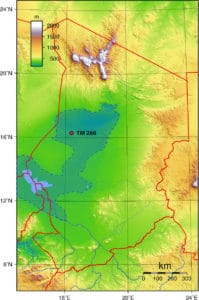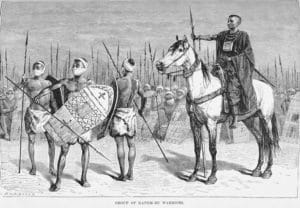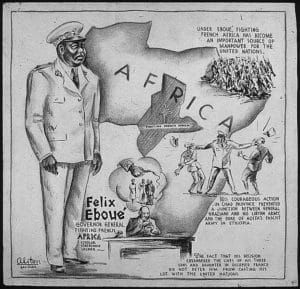
Chad Travel Guide
Geography
Chad is a landlocked country located in Central Africa, resulting in a border shared with multiple neighbors. To the north lies Libya, while Niger and Nigeria border the west. Cameroon and Central African Republic make up the southern border, and Sudan the entirety of the east.
Geographical Zones of Chad
Chad’s geographical range contains three zones: the Sahara Desert to the north, followed by the central semiarid Sahel belt, which phases into the more fertile area in the south, home to Lake Chad and the Logone and Chari rivers that flow into its waters. Also to the south rests Chad’s capital, N’Djamena, the country’s most populous city.
Wildlife
Chad’s wildlife has endured a hostile environment. Poaching dearly decimated the elephant population of Zakouma National Park, but persistent conservation and anti-poaching efforts revived the dwindling elephant numbers, from 400 in 2010 to at last over 500 in 2017. Zakouma also cradles 50 percent of Africa’s Kordofan giraffe population, and thus serves as a key conservation site for this Northern African subspecies of giraffe. In addition, approximately 140 critically endangered West African lion reside in Zakouma during the dry season. The park also hosts 388 bird species, which include the black-breasted barbet, the blue-cheeked bee eater, Abyssinian roller, quelea, and Marabou stork. With its exceptionally conserved status, Zakouma National Park welcomes an abundance of wildlife in a landscape ready for exploration.
The Ennedi region of Chad contains among the best natural phenomena the Sahara Desert has to offer. Rock formations carve out lines and arches that merge with the sky to create a desert skyline free of traffic and air pollution, abundant only with stillness and stars. Gueltas hold pockets of water that nourish camels on their journeys and provide scarce habitats for some of the last remaining desert crocodiles on Earth. Water continues to astonish in Ennedi with the Lakes of Ounianga. The blue hues of these lakes, comprising of eighteen in total, contrast stunningly with the golden Sahara Desert sand. Along these waters you may be able to spot pairs of marbled ducks and their ducklings. Mammals in Ennedi consist of desert dwellers such as Dorcas gazelle, Barbary sheep, and jackal.
Parks
National Parks & Reserves
Despite its past and present struggles with poaching and desertification, Chad retains a solid number of areas dedicated to the preservation of its flora and fauna. These areas consist of:
- Abou Telfane Faunal Reserve
- Binder-Léré Faunal Reserve
- Manda National Park
- Mandelia Faunal Reserve
- Zakouma National Park
Cities
Top Cities
- N’Djamena: Chad’s capital city offers a combination of the country’s colonial remnants and contemporary Islamic and Christian influences. Flying out of N’Djamena International Airport is also the most comfortable and convenient route to Zakouma.
- Fada: The capital of the Ennedi-Ouest region rests in the Ennedi Plateau, home to stellar desert rock formations and the famous Guelta d’Archei. The Lakes of Ounianga are also within reasonable driving distance from Fada.
Things to Do
Things to Do
- Gerewol Festival: A beauty pageant in reverse, this exhilarating festival features men from the nomadic Wodaabe tribe, who adorn themselves in vibrant fabrics and paints in order to win over a panel of marriageable women. Spanning several nights, the festival brims with sound, dance, and color as the lavishly dressed men compete to emerge as one of three winners. On the final night, three eligible bachelorettes scan the male contestants one last time before selecting their desired beaus.
History
Since the 8th century, the fertile region of Lake Chad has served as a settlement for various ethnic groups, with the Sara group forming the majority, while the northern Sahara Desert region has historically hosted semi-nomadic and nomadic peoples. This contrasting relationship with Chad’s topography resulted in tension between the two groups, as the northerners—who along with the rest of North Africa’s nomadic groups became known as “Berbers,”—captured and enslaved people from the South.
From the 9th century onwards, the Berbers continued to penetrate the rest of Chad and eventually formed the Kanem-Bornu Kingdom, which transitioned into an Islamic kingdom in the 11th century. Chad’s imperial chapter begins with the arrival of the French in 1900, who embarked upon their takeover of the country and officially declared Chad a French colony in 1913. Chadians lived under French rule before attaining their independence in 1960.
In 2003, Chad began to produce oil after the completion of the Chad-Cameroon Pipeline Project, which cost approximately 4 billion dollars to construct. The magnitude of this project, one of the largest of its kind in Africa, caused concern amongst human and environmental rights organizations, who cited the risk a pipeline of this caliber poses to local people and ecosystems. Despite this large-scale development, Chad retains distinct natural landscapes such as the lakes and gueltas of the Ennedi region, and the elephants and giraffe that now roam protected in Zakouma National Park to the southeast.



